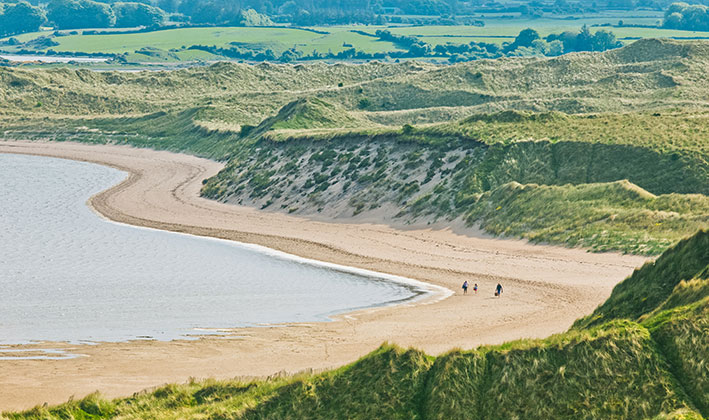At the south end of the beach is the bathing cove called the Sandy Field. There, ancient people used to eat oysters by the shore and left behind the waste shells in heaps called kitchen middens. Look out from there and you may see harbour seals resting on the sandbanks or hear them ‘singing’.
The beach joins the two townlands of Carnadough, in Irish ‘Ceathru na Dumha’ or ‘the quarter of the mounds’, meaning sand dunes, and Culleenamore. The main road from Ballisodare to Sligo ran along the grass banks here for centuries and was still used long after the Top Road (R292) was built in 1836.
The hamlet in Carnadough beside the beach was recorded as early as 1655 in the Down Survey. In 1749 five people lived here and 29 at Culleenamore. A natural spring well in Carnadough provides water and farmers used to bring their cattle down from the mountain to drink at the well.
Over 1,000 years ago, Viking raiders prowled the shores and sailed up Ballisodare Bay to their boat camp at Knoxpark near modern Ballisodare. Later, boats plied the estuary to take grain to the Middleton and Pollexfen flour mills at Ballisodare.
At Culleenamore, Freeman Aeneas Nuttall, a prize-winning horticulturalist, had a market garden at the foot of Knocknarea in the early 20th century. The Culleenamore Violet and Shamrock Farm supplied shamrocks each year to Buckingham Palace in London.
Oyster were harvested at Culleenamore since at least the 17th century and the beds were a valuable asset. Poaching and raids on the beds were recorded many times, including by ‘men from Strandhill’. Culleenamore oysters were famous and won international awards in the 19th century.
In 1934 the old oyster company boathouse was converted into a dwelling and a new pier was built. The well-known actress, Noelle Middleton, lived there for many years until her death in 2016 and produced oysters from the old beds.
FROM HERE YOU CAN:
- Follow the beach around Portcurry Point to arrive at Strandhill or cut back through the Shelly Valley, where orchids, harebells and other wild flowers bloom in season.
- Listen out as you walk to hear the harbour seals ‘singing’ or watch them sunning themselves on the sandbanks.
- Leaving the beach, turn right at the junction with the main road (R292) and head to Ransboro to see historic Kilmacowen church and graveyard (L7509).
Take happy memories with you but leave no litter and respect the ancient monuments. Watch out for other walkers and traffic.













